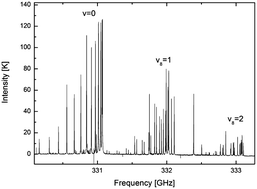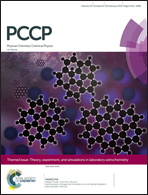A laboratory heterodyne emission spectrometer at submillimeter wavelengths†
Abstract
We present first results on a newly built broadband emission spectrometer for the laboratory making use of a double sideband (DSB) heterodyne receiver. The new spectrometer is perfectly suited for high-resolution emission spectroscopy of molecules of astrophysical importance. The current SIS receiver operates at RF frequencies between 270 and 390 GHz, coincident with Band 7 of the ALMA telescope. The instantaneous bandwidth is 5 GHz (DSB). In this work the full spectrometer and its components are described. Its performance, in particular its sensitivity, stability, reproducibility and systematic errors, is characterized in detail. For this purpose very broad band emission spectra of methyl cyanide have been recorded and compared to theoretical spectra. Isotopic variants are found in natural abundance and features attributed to vibrationally excited species are all recorded in the same spectrum. The performance of the new spectrometer is compared extensively to that of a traditional FM-absorption spectrometer and to recent versions of chirped-pulse spectrometers operated in the mm-wave regime. Further applications and future advancements of the current instrument are discussed.

- This article is part of the themed collection: Theory, experiment, and simulations in laboratory astrochemistry


 Please wait while we load your content...
Please wait while we load your content...